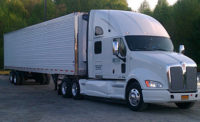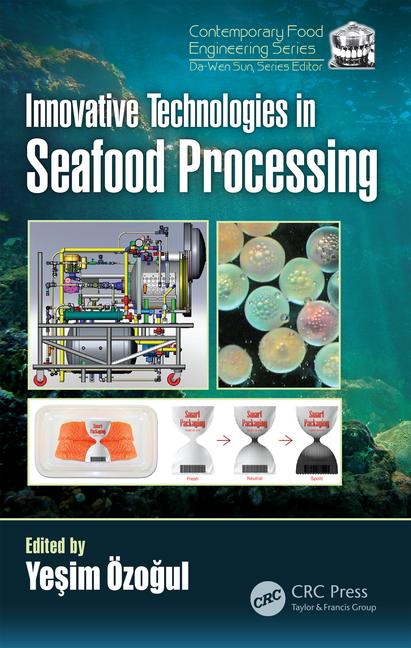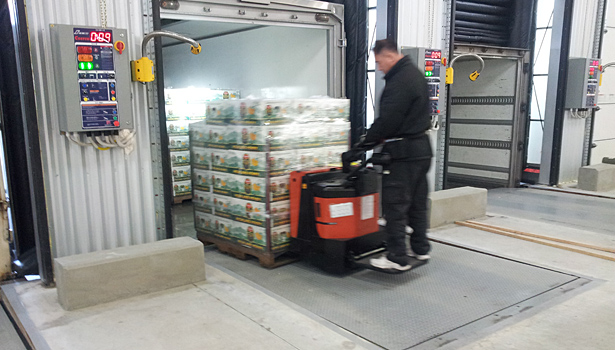How to Obtain an Energy-Efficient Cold Chain












Cold chain refers to a series of uninterrupted temperature-controlled links in a logistics chain. Common items that are stored in a cold storage facility are agricultural produce, such as fruits and vegetables, which spoil easily. In order to prevent spoilage, operators must keep things cool and fresh, however, that often increases energy costs.
According to a report, “Global Frozen Food Market Analysis by Products Type and by Geography—Trends and Forecasts (2010-2015),” the frozen food market experienced an expected growth rate from $218.41 billion in 2010 to $261.50 billion by 2015. It’s true—the cold storage business is undoubtedly a pricey one. In a cold chain logistics system that functions well, you can easily double the shelf life of fresh food. Extending the life of a product can increase return on investment, and in a pricey business that is only set to increase, that is certainly a smart move.
How the leveler plays a major role in a successful cold chain
To maintain a strong cold chain, temperature-controlled loading docks can be outfitted with specialized loading dock equipment, which include Serco’s vertical storing dock leveler that stores upright and inside the building, offering superior energy efficiency. Avertical storing dock leveler (VSL) was designed to meet some of the biggest challenges that face companies in the food, beverage and cold storage industries. Sustaining a clean, energy-efficient warehouse environment is paramount when the product is something as sensitive as temperature-controlled products. The sheer ability to “clean” in, around and underneath a dock leveler is a major advantage. VSLs make for easier washdowns because they cover the impossible-to-reach areas.
Another key feature of this dock leveler is temperature. The VSL allows dock doors to close snugly and tightly against the floor, leaving no gaps and eliminating spaces under doors or other opportunities for energy to escape.
Optimize cold chain with hydraulic rail levelers
Many facilities are taking on a multi-function distribution modal, and thanks to increases in customer expectations, faster shipping times and the like. That’s why intermodal transportation is fast approaching the norm. This is increasingly popular in cold storage solutions whereby a company maintains a full-service refrigerated service where all aspects of perishables logistics—warehousing, inventory control and distribution—are handled by one firm.
In many situations, these business solutions are set up to receive train deliveries directly onsite at their facilities. A hydraulic rail leveler (HRL) is the ideal solution for rail car operations. Similar to its vertical storing leveler counterpart, the HRL rail leveler shares the same high standard of power and safety, and allows deliveries to be unloaded from a rail car straight into the cold storage facility for easy sorting, storing or distribution.
How dock seals protect against the elements
Protecting a climate-controlled facility from energy loss is probably one of the most challenging tasks that any cold storage operator faces. Just consider for a moment the amount of possible opportunities that exist around each dock unit. Installing seals and shelters from the start can provide an exceptional energy seal for climate-controlled loading docks. Dock seals and shelters can be interlocked with loading dock equipment, including doors, vehicle restraints and dock levelers to ensure proper operational sequence and increased energy efficiency.
Yes, cold storage is big business indeed. Engineers work to find the perfect insulation material to protect things like batteries, hard drives and other pieces of equipment that are expected to perform as if they were functioning at room temperature. That’s not the only demand though. Workers also must be protected from these icy temps. Employees who are exposed to such cold storage conditions are geared up with specialty hats, gloves and coats to help maintain a safe internal body temperature while working inside a cold storage facility.
Other contributing factors that any cold storage facility manager must consider is lighting and flooring options. A dock seal is just as critical a component for a cold storage facility as the dock leveler, overhead door, forklifts, etc.
Ask yourself, does my application require full access to the trailer during loading/unloading? Do the trailers that frequent my loading dock have swing doors? These are important questions to ask before purchasing a dock seal or shelter because while a seal is the best answer for energy savings, some seals can impede access to the full width of the trailer, making it difficult to get to pallets at the very back of the trailer or wider loads. And, often seals that spill into the trailer interior get ripped or torn by passing forklifts during the loading cycle.
In cold storage environments, trailers with swing doors are common. When swing doors are opened, they create gaps between the hinges that allow energy to escape, so compressing the trailer into the dock seal closes off these gaps. But, how do you deal if the dock seal impedes access to the interior of the trailer?
Protect against energy loss
Deciding between a dock seal and a dock shelter can be a difficult task, and making the right choice can impact the energy efficiency, sustainability efforts and overall productivity of your cold storage business. As mentioned, conventional dock shelters offer full trailer access, however, when a trailer’s doors are opened for loading or unloading, a series of gaps are created between the trailer hinges. These hinge gaps are substantial and allow weather to enter the facility and precious cooled-conditioned air to escape, increasing risk of spoilage and increasing energy costs. A dock shelter system begins to work as soon as a trailer reverses into the dock, and is automatically activated by the backing trailer by grasping the sides of the trailer and covering the hinge gaps. It offers a consistent seal, full and unrestricted access to the trailer bed and gives way to ultimate energy savings without any interference to loading.
How to secure trailers and enforce safety
When it comes to holding a massive semi-trailer, you need to ensure you have employed the most ideal restraint for the job. Early departure and trailer creep are pressing safety concerns at the loading dock, and are all the more reason why you need sufficient vehicle restraint systems.
A vehicle restraint is a popular solution for safely restraining a trailer at the loading dock. It’s effective at holding trucks tightly in place because it engages a trailer’s rear impact guard. By securing it in such an extensive manner, you are also preventing creep, early departure and helping to increase safety at your cold storage loading dock. This type of vehicle restraint is available in powered and non-powered options.
Another viable option for engaging trailers at your dock is a surface-mounted restraint. This type of restraint can continue to function in extreme weather conditions. This restraint system is also versatile, and doesn’t impede lift gates, landing gear or pup trailers, which means it works with practically any trailer in almost any condition. It’s also automatic, which makes life simpler, especially during busy high traffic times at the loading dock.
A more permanent solution for securing trailers is an in-ground mounted, which means it is flush with the ground, not to impede vehicles that may need to pass over such as a snow plough. It offers continuous force and automatically chocks wheels. This solution is exceptionally versatile; it can service trucks with lift gates that are lowered to gate level.
The other benefit of an effective vehicle restraint is that it keeps the trailer snug against the dock seal or shelter, preventing trailer movement that can create gaps, thereby jeopardizing the effectiveness of the seal/shelter.
More air, more efficiency and more style
An HVLS fan that features an optimized 5-blade profile translates to greater airflow, all while conserving energy consumption. The HVLS fan that is leading the industry in energy efficiency is designed with a refined airfoil shape, which results in less drag and equates to greater circulation and employee comfort. Circulation is a key objective in any temperature-controlled facility. An HVLS fan produces a massive, cylindrical column of air that flows down to the floor and outward in all directions, creating a horizontal floor jet that consistently circulates air in large spaces.It’s an energy smart fan that moves air evenly for more balanced circulation and helps protect product integrity, reduce opportunities for spoilage and increase environmental comfort for employees. The improved airflow also decreases condensation, resulting in drier, safer floors for employees.
Tying the links together into a master control panel
Safety and productivity go hand in hand, link by link. That’s why a master control panel ensures that dock equipment operates in a pre-determined sequence, in some cases, helping automate the operation. Meaning, if the dock doors are open, it’s because loading or unloading is taking place. As soon as loading is complete, the energy-saving dock doors will be shut down as part of the sequence, so no unnecessary energy loss occurs.
The same technique applies to dock lights, dock levelers, dock seals or any piece of equipment that are integrated into the facility’s master control panel. If operators pre-determined something to close or shut down at a certain point, it will do so as part of a sequence, initiated by the push of the button on a master control panel. This sequence also improves safety because users can program it so that the trailer must be securely locked in place by the vehicle restraint first before any other equipment can operate. The dock leveler can be interlocked with the other dock devices, preventing operation until all the safety systems are operational and dock doors are open. You can even set up your dock lights to be programmed to switch on just before the dock equipment begins to function.
Like every link in your cold chain supply chain, treat your temperature-controlled loading dock with the same finesse. For a highly functional and profitable cold chain, ensure that your loading dock is equipped to handle this sensitive supply chain process. Starting from the dock leveler to the dock opening, choose suitable equipment with capable sealing solutions and ensure that you add on a dock shelter system to close off any potential and expensive hinge gaps. Support each link in your cold chain and strengthen safety with a superior vehicle restraint system. Use energy smart technology such as an HVLS fan to circulate air and create a more balanced environment. These fans also conserve energy and reduce air condensation, resulting in drier, safer, floors and reduce opportunities for produce spoilage.
Lastly, waste not, want not or in other words, pre-program a master control panel to integrate all of your loading dock equipment into one intelligent control panel. Not only will this keep your cold storage operation functioning efficiently, but it will also save on energy costs because only necessary equipment will be in use at any given time.
Cold storage may be pricey, but by being smart from the beginning, you can dramatically save on energy costs and support a more energy efficiency environment for your temperature-sensitive product.
Looking for a reprint of this article?
From high-res PDFs to custom plaques, order your copy today!














